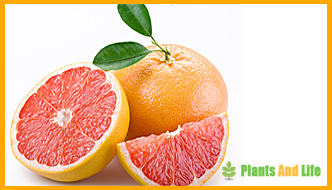
Pamplemousse and pomelo (or pomelo) are ambiguous vernacular names which designate in French two types of citrus fruits which come from two different species of the genus Citrus, of the family Rutaceae: the Asian Citrus maxima and the western hybrid Citrus × paradisi .
Description
- Citrus maxima (also Citrus grandis or Citrus decumana) is a fruit tree called grapefruit whose fruit is grapefruit (in English "pomelo" or "pummelo") in the OECD English-French glossary. He is from Southeast Asia (Indonesia, Malaysia). Its fruit with a thick greenish, yellow or pinkish bark is an edible berry, made up of 16 to 18 quarters filled with seeds. The fruit is early, the harvest is done between October and January. The texture is crisp, not very juicy, the balanced taste sweet, more or less bitter and not very acidic. The fruit can be huge: a Japanese banpeiyu has reached 4.86 kg (10 lb 11.3 oz) with a circumference of 83.5 cm (32.8 in). About fifty cultivars are described.
- Citrus × paradisi is an American hybrid between the grapefruit tree and, according to tradition, the sweet orange tree (Citrus maxima × Citrus sinensis). Its fruit, with a thin bark of yellow or pink color, is an edible berry made up of a dozen quarters. It grows in clusters, hence its English name of "grapefruit" taken up in French by Antoine Risso, Alexandre Poiteau in the Natural history of orange trees (1818) and which was introduced in Europe in 19005. The fruit is late, the harvest is done between January and April depending on the cultivars. The texture is juicy, the taste slightly bitter, more or less acidic. The OECD English-French glossary gives the French name for the fruit: "pomelo", "grapefruit".
The imprecision is amplified by the diversity of trade names for their tangelo hybrids, which under a unique name include hybrids of C. maxima or C. paradisi.
Asian grapefruit is produced and widely consumed from India to Japan and mainly in Indochina, Southeast China and Malaysia. In China there are 4 types of cultivars: the most common with white flesh, the modern ones with red flesh, the latest creations with red flesh and red skin (also produced in Thailand and Taiwan) and finally those with orange flesh, rich in carotenes. . The last two are the most expensive.
The main country in which pomelo (C. × paradisi) is grown is the United States, where the first varieties planted were Duncan (pomelo blond sperm) and Foster (pomelo pink sperm). These first varieties have been replaced by new ones with fewer or even no seeds. The most popular and consumed varieties, including Ruby Red, are now those with red flesh and without seeds. The first pomelo with red flesh was obtained in 1984 by mutagenesis.
Derivatives and drug interactions
C. maxima is not very juicy, only C. × paradisi is used to make grapefruit juice widely distributed (there are buntan juices in Japan) and to produce grapefruit seed extract.
Texts relating to metabolic and drug interactions do not always use the precise binomial name to designate the fruit they are dealing with. The rigorous publications on drug interactions concern grapefruit juice (C. × paradisi) in current French pomelo juice, there is no text describing drug interactions with C. maxima, the true grapefruit of the French language .


